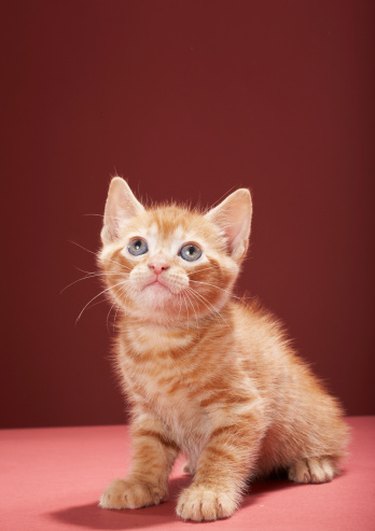Things You'll Need
Cat repellant
Feliway
Waterproof pet pad
Litter pan

Inappropriate cat urination is often due to anxiety from changes such as relocation, or is the cat's way of marking its territory. According to Cat Faeries, a can urinates up to 1 1/4 cup of urine a day, which can wreak havoc on your furniture and walls due to the urine's potent, unpleasant odor. Thankfully, there are preventative measures that repel your feline from from spraying where it pleases, and saves you both time and money by removing the odor from your home.
Step 1
Mix 1 tbsp. of baking soda with water to create a paste, and wipe down the walls to neutralize the cat's urine odor. The urine's enzymes are strong and lures the cat back to the same spot unless it is neutralized to remove the odor. Tape a plastic sheet against the walls to protect them from the cat's urine until the marking issues subside.
Video of the Day
Step 2
Spray cat repellent on the furniture's surface and along the wall's edges. If a cat tends to urinate in a specific area, the cat repellent spray contains an odor that will keep the cat away, and is safe to use.
Step 3
Lay a waterproof pad on your furniture. The couch and bed tend to be favorite sleeping spots for cats, and are also susceptible to cat urination. You can also use clear plastic runners, turned upside down so that the prickly nubs on the runner are facing up. Your cat won't be able to walk on it.
Step 4
Spray Feliway onto the edges of the couch and along the edge of the wall. Feliway is a pheromone spray that soothes cat anxiety by reproducing pheromones naturally produced by the cat.
Tip
Feed the cat on time regularly. A shift in feeding times can cause your feline to feel anxious, which increases urination according to Cat Faeries (See Reference 2).
Neuter your cat when it is a kitten. Cats begin marking territory after six months of age, according to Pet Education. By neutering your cat at an early age you significantly reduce the likelihood of marking.
Take your cat to the veterinarian, who may prescribe behavioral medication to stop marking problems.
Take your cat to the veterinarian to be checked for a urinary tract infection. Urinary tract infections causes pain while urinating, which can cause your cat to avoid using its litter box, according to Vet Info.
Close curtains. A cat that notices other animals outside marks its territory, according to Pet Education. A closed curtain or shades blocks the cat's view of outside cats and reduces territory marking.
Add an additional litter pan if your cat stops using her original litter pan due to urinary problems, according to Vet Info.
Warning
Feliway can cost up to $40 depending on the bottle size, and may not work to repel your cat from furniture.
Video of the Day